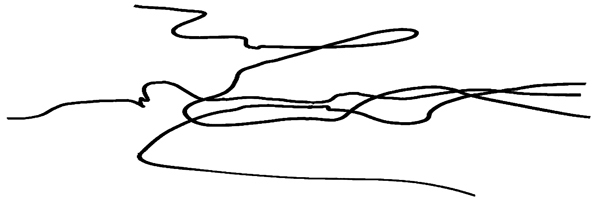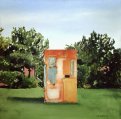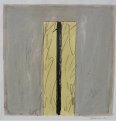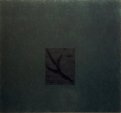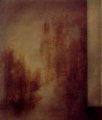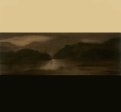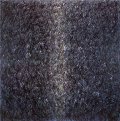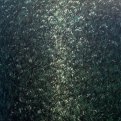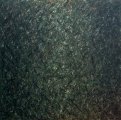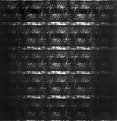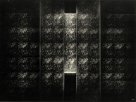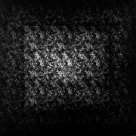M A R C A S E
GRAFTING OF DIFFERING SIGNIFICANCES
Prof. Dr. Willem Elias: Vrije Universiteit Brussels Cat. Marcase, Moving Space. 1989 Translated by Dirk Crommelinck
The pure work of art is not a work of art, but a material thing; for instance a flat with spots of paint, a bearer with a medium. No work exists without the existence of another work. Nevertheless, those people who would have used, in earlier days, the word 'exist' on purpose; the existentialists, believed that everything was to be found within the work, but nothing out of it. Their opponents in that matter, the so-called structuralists, thought of it the other way around. A work of art can only get its meaning from things that occur around it. In his late work, Marcase touches that specific topic. Early on, Marcase has been paying a lot of attention to the serial and the system of significance production attached to the serial mostly consisted of slowly advancing evolutions based upon a repetitive cadence. Each time there was staged a slight difference, so that within the structure, built up by the repetition. a meaning came to life by creating that slight difference. Not what existed, but what didn't exist determined the meaning. It showed exactly what other surrounding works did not: difference. Nowadays, Marcase hasn't broken with the serial, but with the evolutive linear: a rupture in the continuity of his serial thinking. He breaks the time-lag by picking up earlier work in a new entity next to recent realizations, thus shaking up the idea of entity itself. What existed on itself before, what was entity, is now boarded and creates a new unity containing a strange element. Strange because originated in another constellation, to become unstable itself as a temporary totality, because the new element gets an own historicity as well. Both levels of painting are grafted upon each other: Thus their meaning has grown together. Back to philosophy. One could carry back the main debate in present-day thinking to the difference in worldpicture between Plato and Nietzsche. Then one acquires a notable succession of oppositional notions: earnestness and playfulness, the fundament and its dismantlement, the centre and the absence thereof, the origin and what always comes before it: the whole and its completion, the oneness and the want or the surplus, the referring and the aesthetical action, sense and meaning,figure and track, the being and the difference, what is present and what detached, the face to face of sub-jeçt and object and the mutual insertion of bath in a proces of concatenation. In the succession of oppositional notions, Marcase clearly associates with the thinking-power considered by Nietzsche. To Nietzsche, there are no facts, only interpretations. The truth becomes an illusion, and knowing the truth originally served as a means of human selfmaintenance. This instrumental and illùsory characteristic of the truth was, according to Nietzsche, forgotten, so that people started to believe in the truth as if it was the entrance to the essence of reality. In his late work, Marcase shows us this fundamental interpretative characteristic of the human .point of view on reality. In that way, his work becomes a metalinguistic art, a reflection of art on art. This occurs in a very special way. By grafting an earlier work upon a later one or vice versa, a new relation originates between what Nelson Goodman calls a pattern-card and the world to which this card refers. In the new picture-level, Marcase shows, through his own writing, it is true; aspects of 'picturality', which he confronts with each other in a state of tension of almost zero degrees. The disruption however unchains a new meaning. First alienating by the dislocation, then suddenly broaching a new meaning as a juxtaposition. The older work becomes an example of the principles that exemplify the new work. The exemplification signifies, as in a pattern-card, that some features stand out more clearly. The pattern-card refers to the whole, without possessing all the characteristics of it. Marcase fully joins the fundamental art of painting, i.e. the art of painting in search of its own fundaments, but luckily finding only a pattern-card of them. The new panels are referring in twofold. Firstly, they show the elements of the pictural qualities: soft or rough texture, crusty densely covering or1ransparent density. Secondly, referring to the of universal art of painting or at least to two opposite ways of painting, in which the same facts are differently interpreted. It is this different interpretation that makes clear the differing of the medium. Through the juxtaposition of the old work, a relationship to an earlier work; result of applying the pattern-card; orginates, then hidden because present in the inner life. Thus there is a double relationship. For the experiment of the fundaments is not really a pattern-card, but exists as autonomous painting. From this double bond a multitude of meanings arises like Derrida's deconstruction. Let us now leave out philosophy. The recent work of Marcase is a further step in his development of forms, after a break. Marcase started his oeuvre with reflections upon nature. The transience of nature was conceptually embedded in repetitive work: the eternal return of the identical. This static constatation led to a dynamic principle that created movement in the tangle of cutting coats of paint. From an overflowing composition, sometimes bearing a discolouring streak of light, he developped info the inquiry of breaking-points of the linear expansion of lines: the engraving as an indication of the turn. AII of this was do ne on the sensitive background of small piaster tables, penetrable bearers of the registration of immediate 'grafism'. In the margin, the colours were set: the limits of the ritmic game. Lines and colours have found each other again, after the mutual excommunication. They are not pure, they cannot be numbered in the classifications of the colourman. Intertwining relationships, the category of colour-likes: drab, transparents, blue-green and vice ver- sa, metallics, spotted intellectual, pale, unobstinate transparent, refusing to cover. In some place disturbed by a piece of crusty paint, like a stone in a froggery. Sometimes concentrated around a block, protruding out of the flat. A protesting detail facing the serenity of the name refusing colour-likes. A thorn in the side of the meditating spectator: But the allegation itself makes us think. It breaks through the unreflecting brooding and puts the necessary questions. It restrains us of a journey to one pole, shows us earth next to air, fire next to water: In these panels of meditation (the East is near) appearsa line. Not as spasmodic as in the previous phase in Marcase's painting, but rather resigned, reconciliated. Now excitingly agressive, now let-down depressive. Regenaration, but transience as well. The line is in search of its way: elegantly or abruptly, smoothly or jerkily. Calligraphically rivalling Beauty itself or introvertly signalling the identity of its engraving hand. Volatile floating above the colourfulness of its background or penetratingly scratching the vulnerability of its bearer: With or without the philosophy, it becomes clear that Marcase has an eye tor the dialectics between two poles that continually disturb each other's hegemony. Through this disturbance they gain a constant differing balance. The terms, used by Nietzsche, that refer metaforically to these two ways of looking at the world, are not far off. To Nietzsche to live is to interpret. The will is the centre of things. He juxtaposes Apollinic and Dionysian as two different ways of interpretation, as two kinds of will, namely the desire tor the great, the complex, the uncertain, the startting. But in bath cases, Nietzsche finds that art justifies rite. To him, aesthetics are far more important than ethics. Therefore he regrets that in the survey of philosophy the artist is left out. A century later there's hardly any change. Luckily philosophy is not left out where art is concerned. |
|
